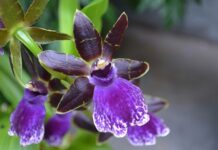Welcome to the captivating realm of African violets, where beauty, history, and cultural significance intertwine to create a truly enchanting experience. In this exploration, we’ll delve into a tapestry of intriguing topics, from uncovering fascinating facts about African violets to celebrating the remarkable records and achievements within the horticultural world. We’ll also journey across cultures to discover the profound symbolism and significance that African violets hold in different societies.
Interesting facts about African violets
Embark on a journey through the fascinating world of African violets and uncover some intriguing facts about these beloved houseplants:
- Native to East Africa: African violets (Saintpaulia) are indigenous to Tanzania and Kenya, where they thrive in the moist, shaded environments of the Usambara Mountains.
- Named after Baron Walter von Saint Paul-Illaire: The genus Saintpaulia was named in honor of Baron Walter von Saint Paul-Illaire, who discovered the plant in Tanzania in the late 19th century.
- Continuous Blooming: African violets are known for their ability to bloom continuously throughout the year under the right conditions, providing a steady stream of colorful flowers.
- Wide Range of Colors: These plants come in a wide range of flower colors, including shades of purple, pink, blue, white, and red, as well as various bi-color and multi-color combinations.
- Fuzzy Leaves: African violet leaves are typically fuzzy or velvety to the touch, helping them retain moisture and resist damage from pests.
- Growth Habit: They have a compact growth habit, making them ideal for indoor cultivation in pots or containers. With proper care, they can grow into lush, bushy plants.
- Easy to Propagate: African violets are relatively easy to propagate from leaf cuttings, allowing enthusiasts to expand their collection or share plants with friends and family.
- Popular Houseplants: These charming plants have been popular houseplants for over a century, valued for their long-lasting blooms, attractive foliage, and ease of care.
- Symbolism: In addition to being decorative houseplants, African violets hold symbolic meanings in different cultures, representing qualities such as love, faithfulness, and good fortune.
- Hybridization: Over the years, extensive hybridization efforts have led to the development of thousands of cultivars with a wide range of flower forms, sizes, and patterns, offering enthusiasts an abundance of choices to suit their preferences.
Records and achievements in the world of African violets
Delve into the world of African violets and discover some notable records and achievements that have shaped the horticultural landscape:
- Largest Flower: Some African violet cultivars have achieved records for producing exceptionally large flowers, with blooms measuring over 3 inches in diameter, captivating enthusiasts with their impressive size and beauty.
- Longest Blooming Period: Certain varieties of African violets have been recognized for their exceptional ability to bloom continuously for extended periods, delighting growers with a profusion of flowers year-round.
- Unique Color Combinations: Breeders have achieved remarkable feats in creating African violet cultivars with unique and striking color combinations, including rare hues and intricate patterns that captivate the eye and inspire admiration.
- Award-Winning Cultivars: African violet enthusiasts participate in competitions and exhibitions where top-quality cultivars are judged based on criteria such as flower form, color clarity, and overall plant health. Winning cultivars receive prestigious awards and recognition within the horticultural community.
- Hybridization Breakthroughs: Breeders continually push the boundaries of African violet hybridization, introducing novel traits such as double flowers, fringed petals, and variegated foliage through innovative breeding techniques and careful selection.
- International Recognition: African violets have garnered international acclaim, with dedicated growers and breeders spanning the globe, contributing to the diversity and advancement of this beloved plant species.
- Cultural Significance: Beyond their horticultural achievements, African violets hold cultural significance in various societies, symbolizing qualities such as beauty, grace, and perseverance, and enriching the lives of people around the world.
- Conservation Efforts: Efforts are underway to conserve and preserve rare and heirloom African violet cultivars, ensuring their continued existence for future generations to enjoy and appreciate.
- Educational Outreach: Organizations and societies dedicated to African violets offer educational programs and resources to promote awareness and appreciation of these plants, fostering a community of passionate enthusiasts and advancing knowledge in the field of horticulture.
Cultural significance and symbolism in different cultures
Explore the rich cultural significance and symbolism of African violets across different cultures:
- Victorian Era: In Victorian times, African violets symbolized modesty, faithfulness, and spirituality. They were often exchanged between lovers as tokens of affection and were cherished for their delicate beauty and enduring nature.
- Asian Cultures: In some Asian cultures, African violets are associated with prosperity, good fortune, and abundance. They are believed to bring luck and happiness to homes and are often displayed during festivals and celebrations.
- Eastern Europe: In Eastern European folklore, African violets are considered symbols of protection and healing. They are believed to ward off negative energies and promote harmony and well-being within the home.
- Native American Traditions: African violets hold spiritual significance in Native American traditions, where they are revered for their connection to the natural world and their ability to uplift the spirits and bring joy to those who cultivate them.
- Modern Symbolism: In contemporary culture, African violets are often seen as symbols of beauty, grace, and resilience. They are cherished for their ability to thrive indoors and brighten up any space with their colorful blooms and lush foliage.
- Gifting Customs: Across cultures, African violets are popular gifts for special occasions such as birthdays, weddings, and housewarmings. They symbolize love, friendship, and best wishes for happiness and prosperity.
- Religious Significance: In some religious traditions, African violets are used in rituals and ceremonies to invoke blessings and divine favor. They are seen as symbols of purity, devotion, and spiritual enlightenment.
- Artistic Inspiration: African violets have inspired artists, poets, and writers throughout history, serving as motifs in paintings, literature, and music. They symbolize the beauty and fragility of life and evoke feelings of nostalgia and longing.
- Community Bonds: Cultivating African violets fosters a sense of community and camaraderie among enthusiasts, who share tips, stories, and experiences related to their love of these plants. They symbolize the bonds of friendship and the joy of shared interests.
Fun ways to incorporate African violets into daily life
Discover creative and enjoyable ways to incorporate the beauty of African violets into your daily life:
- Decorative Displays: Arrange African violets in decorative pots or containers and place them as centerpieces on tables, shelves, or windowsills to add a pop of color and elegance to any room.
- Living Wall Art: Create living wall art by arranging multiple African violets in a vertical planter or frame. This unique display adds visual interest and natural beauty to your home décor.
- DIY Terrariums: Design your own mini terrariums using glass containers or jars filled with soil, moss, and small African violet plants. These charming terrariums make delightful accents for desks, countertops, or mantels.
- Edible Garnishes: Add a touch of color and flavor to your culinary creations by using African violet petals as edible garnishes for salads, desserts, or cocktails. Simply rinse the petals and sprinkle them on your dishes for a whimsical touch.
- Homemade Potpourri: Dry African violet blooms and leaves to create fragrant potpourri blends. Mix them with dried herbs, spices, and essential oils to create custom scents that freshen up your home and lift your mood.
- Gift Giving: Share the joy of African violets with friends and loved ones by giving potted plants or homemade gifts featuring African violet motifs, such as hand-painted pots, floral arrangements, or framed artwork.
- Crafting Projects: Get creative with crafting projects using African violet leaves and blooms. Press dried petals to make greeting cards, bookmarks, or framed artwork, or use leaves to create botanical prints or jewelry.
- Aromatherapy: Enjoy the soothing fragrance of African violets by placing potted plants in bedrooms, bathrooms, or relaxation areas. The subtle scent promotes a sense of calm and tranquility, enhancing your overall well-being.
- Outdoor Décor: Incorporate African violets into your outdoor living spaces by displaying them in decorative planters on patios, balconies, or garden beds. Their colorful blooms and lush foliage create a charming ambiance in any outdoor setting.
Unique and unusual varieties and mutations
Explore the fascinating world of unique and unusual varieties and mutations of African violets, showcasing nature’s creativity and diversity:
- Variegated Foliage: Some African violet varieties exhibit variegated foliage, featuring striking patterns of contrasting colors, such as white, cream, or yellow, marbled or splashed across the leaves, adding visual interest and intrigue.
- Double-flowered Forms: Double-flowered African violets boast extra layers of petals, creating lush, ruffled blooms that resemble miniature roses or carnations. These varieties add a touch of opulence and elegance to any collection.
- Frilled or Ruffled Edges: Certain African violet cultivars feature petals with frilled or ruffled edges, adding texture and dimension to the flowers. These varieties showcase delicate, intricate details that enhance their beauty and charm.
- Miniature and Micro Varieties: Miniature African violets are compact plants with tiny leaves and blooms, making them ideal for small spaces or fairy gardens. Micro varieties are even smaller, with leaves and blooms measuring just a fraction of their larger counterparts.
- Novel Color Combinations: Breeders have developed African violet varieties with unique color combinations, such as lavender with pink edges, blue with white centers, or peach with purple veining, pushing the boundaries of traditional flower colors.
- Striped or Speckled Blooms: Some African violet blooms feature striped or speckled patterns, adding a whimsical touch to their appearance. These varieties showcase nature’s playful side and offer a delightful surprise with each bloom.
- Giant Blooms: While most African violets produce petite blooms, some varieties have been bred to produce larger-than-average flowers, with blooms measuring several inches in diameter. These giant blooms make a bold statement and are sure to impress.
- Fragrant Varieties: Although African violets are not typically known for their fragrance, some varieties have been bred to produce subtle scents reminiscent of violets, adding another sensory dimension to their appeal.
- Novelty Forms: Breeders have experimented with novel flower forms, creating African violet varieties with unique shapes, such as star-shaped, spoon-shaped, or pinwheel-shaped blooms, adding intrigue and novelty to collections.
FAQs about Enchanting World of African Violets
African violets are fascinating plants known for their vibrant flowers, fuzzy leaves, and ability to bloom year-round. They originate from Tanzania and Kenya and belong to the Gesneriaceae family.
The African violet community boasts impressive achievements, including breeding breakthroughs that have produced unique flower colors, patterns, and forms. Some cultivars hold records for the largest blooms or most vigorous growth.
African violets hold diverse symbolism across cultures. For example, in Victorian times, they symbolized modesty and faithfulness, while in some Asian cultures, they represent prosperity and good fortune.
African violets can be incorporated into daily life in various creative ways, such as using them as table centerpieces, crafting homemade potpourri with dried blooms, or adding their petals to salads for a colorful touch.
Yes, the world of African violets is rich with unique and unusual varieties and mutations, including rare color variations, double-flowered forms, and variegated foliage, each adding intrigue and diversity to collections.
Conclusion:
Our journey through the enchanting world of African violets has been a delightful exploration of beauty, culture, and creativity. From uncovering fascinating facts to celebrating the achievements of dedicated growers and breeders, we’ve gained a deeper appreciation for these charming plants. Exploring their cultural significance and symbolism across different societies has offered insights into the enduring allure of African violets. Furthermore, discovering fun and inventive ways to incorporate them into our daily lives has added a touch of elegance and joy. Finally, marveling at the diversity of unique varieties and mutations has showcased nature’s boundless ingenuity. As we bid farewell to this enchanting journey, let us carry with us the timeless beauty and endless possibilities of African violets, enriching our lives with their grace and charm.










